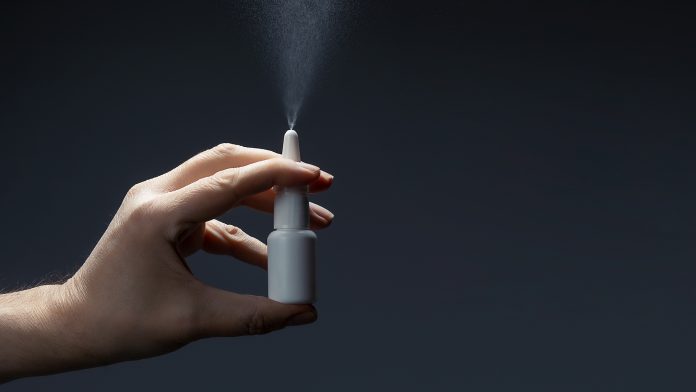
Marinomed’s CSO, Dr Eva Prieschl-Grassauer explains how Carragelose can offer an extra line of defence against respiratory infection, including coronaviruses and support infection control.
From social distancing to wearing masks, there is now a range of infection control measures that many of us are adhering to in our daily lives to mitigate the risk of contracting threatening viruses. As we know, certain groups, including frontline workers and older adults are more susceptible to infection, so it is important that whole populations can play their part in reducing the risk of transmission. Vaccines have, undoubtedly, offered a strong line of defence against the coronaviruses but must be re-administered to maintain efficacy, and this, as we know, has not been easy. In a bid to offer a scalable and accessible antiviral tool that people can use as and when they feel it is necessary, an Austrian science-based biotech company, Marinomed Biotech AG, released a Carragelose-based nasal spray which has been proven to trap respiratory infection viruses, including SARS-CoV-2.
To find out what makes Carragelose particularly effective, and the benefits an antiviral nasal spray can offer alongside vaccines against respiratory infection, HEQ spoke with Marinomed’s CSO, Dr Eva Prieschl-Grassauer.
What properties make Carragelose an efficient antiviral compound?
Carragelose is a particular subtype of carrageenan which is exclusively extracted from red algae. In the commercial field, including for food and cosmetics, the main subtypes used are iota-, kappa-, and lambda-carrageenan. Around 15 years ago, our company began testing different types of carrageenan, as well as other polymers from algae, against respiratory viruses and we found that Carragelose (iota-carrageenan) is very broadly active in inactivating or neutralising those viruses. Kappa, we found had weak efficacy and lambda has a different profile completely, leading to a pro-inflammatory reaction.
Initially, we started experimenting with rhinoviruses which are non-enveloped viruses. Upon discovering that non-enveloped viruses were also a target for these polymers, we decided to get IP protection for these products. From here, we took it further to test the carrageenans against the RSV (respiratory syncytial virus) and other respiratory infection viruses and found that the iota-carrageenan was extremely active against these viruses.
The working hypothesis is that those viruses that infect the mucosal surfaces of the respiratory tract have something in common in the way they attach to the surface, otherwise they would not be able to reach the cells for replication. We know these viruses have a positively charged surface and the iota-carrageenan, in contrast, is a heavily, negatively charged polymer. Due to its secondary structure, these negative charges are also optimally set apart.
Carragelose is a very large molecule, much larger than antibodies, and it is therefore not possible for it to permeate through membranes. We have done several safety studies in vivo which show that Carragelose does not permeate through the nasal mucosa and thus stays outside at surface level. Our experiments also revealed that the molecule stays in the nasal mucosa, or in the nasal cavity, for much longer than normal saline, which is typically 20 minutes. Carragelose is able to stay on the surface and inactivate viruses for four hours on average, this varies from person to person depending on their health and lifestyle.
We chose to focus on respiratory infection viruses in particular because these viruses can be reached by such a molecule and treated topically. However, with more life-threatening viruses like HIV, it cannot be reached in this way, with a polymer, because it cannot be given intravenously. The subunits of Carragelose are structurally too similar to heparin, and we would therefore risk an adverse event if you had it in your bloodstream.
Can you give a brief overview of how the nasal spray works?
Where there is a newly infected cell that the virus has managed to enter, thousands more viruses can be produced within a certain amount of time and then released to neighbouring cells. However, as long as iota-carrageenan is present when the viruses are released from the cell, they get neutralised and therefore limit further spread within the individual.
We carried out a study, in a therapeutic setting, at the Common Cold Centre in Wales whereby 35 individuals with early symptoms of the common cold, a respiratory infection, received iota-carrageenan and the viral load was strongly reduced, by approximately 95%. In the placebo group, however, there was a six-fold increase of viral load within three days, so there was a huge gap between the two groups. There was a significant reduction in symptoms within the four days, which is in parallel to the reduction in viral load. This was the first trial where we saw effectiveness.
We also did another, larger trial with around 150 children and around 200 adults and again saw a huge reduction in viral load in the nasal cavity after treatment. However, in some children, though there was a significant difference in terms of the duration of their symptoms, the iota-carrageenan did not alleviate acute symptoms of the common cold due to other co-medications and secondary infections that children are more susceptible to.
How effective is the nasal spray against COVID-19 and its variants, including Omicron?
An independent study was carried out in Argentina whereby 400 subjects from the healthcare system took the nasal spray four times daily. They saw an 80% reduction with respect to COVID-19, and this is very promising as it is the first time that prophylaxis has been tested with a nasal spray.
We understand this prophylactic clinical trial does not currently have the same scope as the vaccines. At the same time, one has to understand that in vaccine trials, usually you are looking for safety issues as opposed to efficacy. Vaccine trials are typically large to pinpoint potentially rare side effects, whereas, in the case of efficacy trials, these are usually smaller. You must justify the number of subjects included in a clinical study to the ethics committee by assessing the expected effect, and also the spread within subjects.
With respect to the variants, we have currently tested the alpha, gamma, beta and delta variants in partnership with the University of Erlangen-Nuremberg in Germany and found there to be no difference in terms of efficacy. This is very promising for new upcoming variants, as we know that the product works against the old coronaviruses too, there is very good evidence that there will be no dramatic change concerning efficacy. Knowing that the Omicron variant carries multiple positive surface charges it is likely that Carragelose will maintain efficacy.

What was your impetus behind the creation of the Carragelose nasal spray?
For me, the nasal spray is one additional measure to the vaccine and other infection control procedures like wearing a mask. It provides an extra line of defence which will be particularly useful when travelling, for instance, in crowded spaces or meeting with people you see less frequently. Beyond the pandemic, the spray can also be used as a therapeutic in adults because they tend to forget about prophylaxis as long as they are not symptomatic. It is not on purpose, but you just forget about it, especially if you are not in an epidemic situation; adults can therefore use it as a therapeutic virus-blocking tool. At the moment, we see peak sales because it is one additional, protective measure that people can take themselves when they feel it is necessary.
What additional benefits can the nasal spray offer alongside the COVID-19 vaccine? For instance, as a line of defence for young children.
We have data for children, starting from the age of one, so it could absolutely be a useful measure for those who are too young to have the vaccine. Generally, I think people feel more comfortable knowing there is an additional tool available with which they can protect themselves. Likewise, it can be useful for more vulnerable members of society as well as if the vaccine is not working as effectively against new virus strains or protection starts to ease after a certain amount of time. There are certain groups of society who may need to get vaccinated quite often to stay protected, but I think this is a difficult task for the general population, so you can help yourself by using a virus-blocking spray.
Dr Eva Prieschl-Grassauer
CSO
Marinomed
www.marinomed.com/en
This article is from issue 20 of Health Europa Quarterly. Click here to get your free subscription today.










